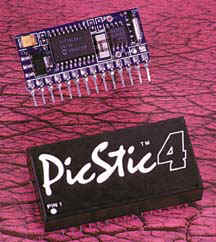PicStic 1-4

The basic PicStic offers both compatibility and improved performance over the BASIC Stamp I. It comes in four versions: PS1, PS2, PS3, and PS4. The PS1, PS2, and PS3 are all pin-compatible with the Parallax BASIC Stamp I (BS1). The PicStic1 is a straight one-for-one programmable replacement for the BS1.
The PicStic2 has all the features of the PicStic1 plus a real-time clock/calendar that keeps time in terms of the year, month, day of the month, day of the week, hour, minute, and seconds. The clock always runs while the PicStic2 is powered. An optional 3-V lithium battery maintains the clock when power is off. The battery, which is approximately 0.6 inches in diameter, can be mounted on the front or back of the PicStic2.
The PicStic3 has all the features of the PicStic1 plus a 2-channel, 12-bit ADC. The compiler contains library routines for reading the ADC and real-time clock.
PicStic4 consists of a user-programmable controller, similar in most respects to our original PicStic1, enhanced with an intelligent I/O coprocessor. The coprocessor provides extended data memory, automatically reads and sets 12-bit analog I/O, reads or sets the real-time clock, and supports up to 19 bits of parallel I/O. Beyond the physical attributes, the coprocessor also provides numerous processing and data management functions which can be accessed from the controller side.
Complicated program tasks like scanning keypads, driving an LCD display, recording Vmin, Vpeak, and Vavg analog readings, reading and setting the real-time clock, recording important data in extended nonvolatile memory, totaling events, reading frequency, generating a constant PWM output, or reading Dallas Semiconductor iButton serial numbers, are all provided as simple callable functions from the I/O coprocessor. PicStic4 is designed to provide the user with a cost-effective and easily programmable control device without requiring the user to eat up valuable controller-side programming space with all the low-level code typically necessary to perform useful monitoring and control activities.
While PicStics 1-3 are BASIC Stamp I pin-compatible, you can program all PicStics in more than BASIC. Unlike the customized hardware of the BASIC Stamp, PicStic uses a generic reprogrammable PIC16F84 processor and customized compiler. Additional features and improvements typically involve recompiling your program, not buying new hardware.
The single major advantage of the PicStic is that you get additional I/O lines and access to the four PIC16F84 interrupt sources when using assembly language (or an assembly-language call appended to PicBASIC or C). With an ADC, interrupts, and 10 I/O lines, the PS3 provides a powerful little controller for cost-conscious applications.
Using the PicBASIC compiler, PicStic 1 is 100% Stamp I compatible. As a bonus, it's also at least 15 times faster for the same crystal speed.
PicStics are now available with double the program space, double the data EEPROM space, and over three times the RAM space. The 2k version is available for the PicStic 1, 2, 3, and 4. Micromint's part number is PicStic 1-2k, PicStic 2-2k, PicStic 3-2k, PicStic 4P-2k, PicStic 4Q-2k and PicStic 4X-2k.
PicStic 5
The PicStic 5 is a low cost industrial-oriented controller designed around the PIC16F876. The PicStic 5 incorporates digital inputs, digital outputs, analog inputs, analog outputs, extended data memory, and serial communication all in a single 0.8-cubic-inch encapsulated module.
The PicStic 5 utilizes a pair of communication line drivers to allow several types of serial communication. RS-232A, RS-422, and RS-485 protocols are available with the PicStic 5. With an 8MHz-system clock, the PicStic 5 has the ability to communicate serially at baud rates up to 250Kbps. This becomes beneficial when time is a factor. SPI and I2C communications are also available. These buses are made accessible through pins 23-25. During I2C communication the SCL frequency can be set at 100KHz, 400KHz, or 1MHz. During SPI communications, bits can be clocked out at rates up to 2MHz. In SPI and I2C modes received data is double buffered allowing a second byte of data to be received before the first byte is processed.
Accompanying the 4-channels of 10-bit analog-to-digital converters supplied by the PIC16F876 processor, the PicStic 5 also offers 2-channels of 12-bit analog-to-digital conversion. The two 12-bit channels can be sampled at approximately 10K samples/sec. The four 10-bit ADC channels can be sampled at approximately 20K samples/sec. There are 2-channels of 12-bit digital-to-analog conversion included in the PicStic 5. These analog outputs have a range from 0-4.095V. Both channels are loaded simultaneously.
The PicStic 5 has 16 bi-directional bit-programmable, high-current I/O lines capable of sinking/sourcing 25mA.
The PicStic 5 can be programmed using a Micromint supported BASIC Compiler, straight assembly language, or a C compiler (not supported by Micromint Inc).
Datasheets
|
Data Sheets |
PDF (full) |
|
|
PicStic 1-3 |
||
|
PicStic 4 |
|
|
|
PicStic 5 |






